Shady sites tend to be some of the trickiest ones to fill in a yard, especially the patches of dirt under trees and shrubs and the neglected spots around your home and other structures.
You could just throw a layer of mulch on top and call it good, but you could also make those spaces an intentional part of your garden with a shade-tolerant ground cover. These ground covers are low-maintenance (or even no-maintenance), hard-working (smothering weeds and protecting the soil while they sit pretty), and economical (just plant them once and enjoy them for years to come).
I’ve divided my favorite low-light options into two types of ground covers: those that thrive in partial shade (four to six hours of sun) and those that don’t mind full shade (less than four hours of sun).
While all of these plants are perennial, some of them may die back after a hard frost (depending on your climate). If you’re looking for color and beauty year-round, check out my list of ground covers that stay green even in winter.
For other spaces in your yard, I’ve even got a guide on growing beautiful ground covers you can eat (ideal for vegetable gardens) and resilient ground covers you can walk on, too.
Partial shade (4 to 6 hours of sun)
Barren strawberry (Waldsteinia fragarioides)
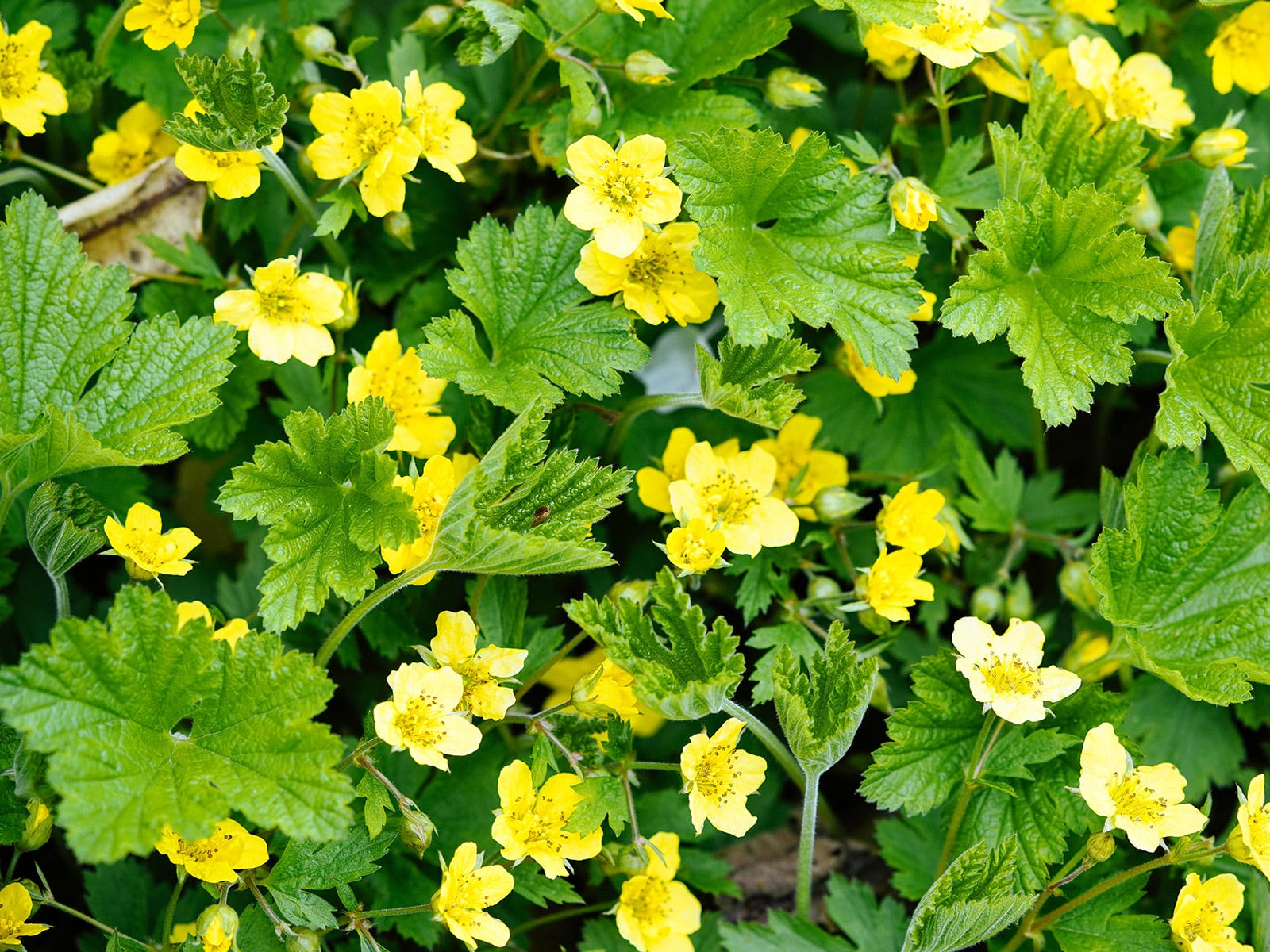
If you’re looking for a pretty ground cover plant that also has flowers, the barren strawberry is a great choice. Although it belongs to a different genus than real strawberry plants (and doesn’t produce fruits, hence the name), it does bloom a lovely yellow in spring.
There’s plenty to love about the barren strawberry. For starters, it’s a native plant, naturally found in eastern North America. It doesn’t mind a relatively shaded location, is versatile in terms of soil as long as drainage is good, and won’t grow so quickly that it chokes out your other plants.
- Soil type: Well-drained and loamy
- USDA Zones: 4 to 7
- Water: Medium
- Withstands foot traffic: Light
Bugleweed (Ajuga spp.)

More pretty flowers, this time in shades of blue and purple! “Bugleweed” is a common name for members of the genus Ajuga, which belong to the mint family. There are dozens of different bugleweed species, but the one most commonly grown as a ground cover is called Ajuga reptans, also called common bugle. It’s one of the most cold-hardy ground covers that actually keeps most of its foliage through winter.
Common bugle grows to a maximum height of less than 6 inches. The wild form has decorative bronze and green foliage, but you can also opt for one of the many cultivars. I particularly like ‘Chocolate Chip’ and ‘Black Scallop’ myself!
- Soil type: Moist but well-draining
- USDA Zones: 3 to 10
- Water: Medium
- Withstands foot traffic: Light
Creeping speedwell (Veronica repens)
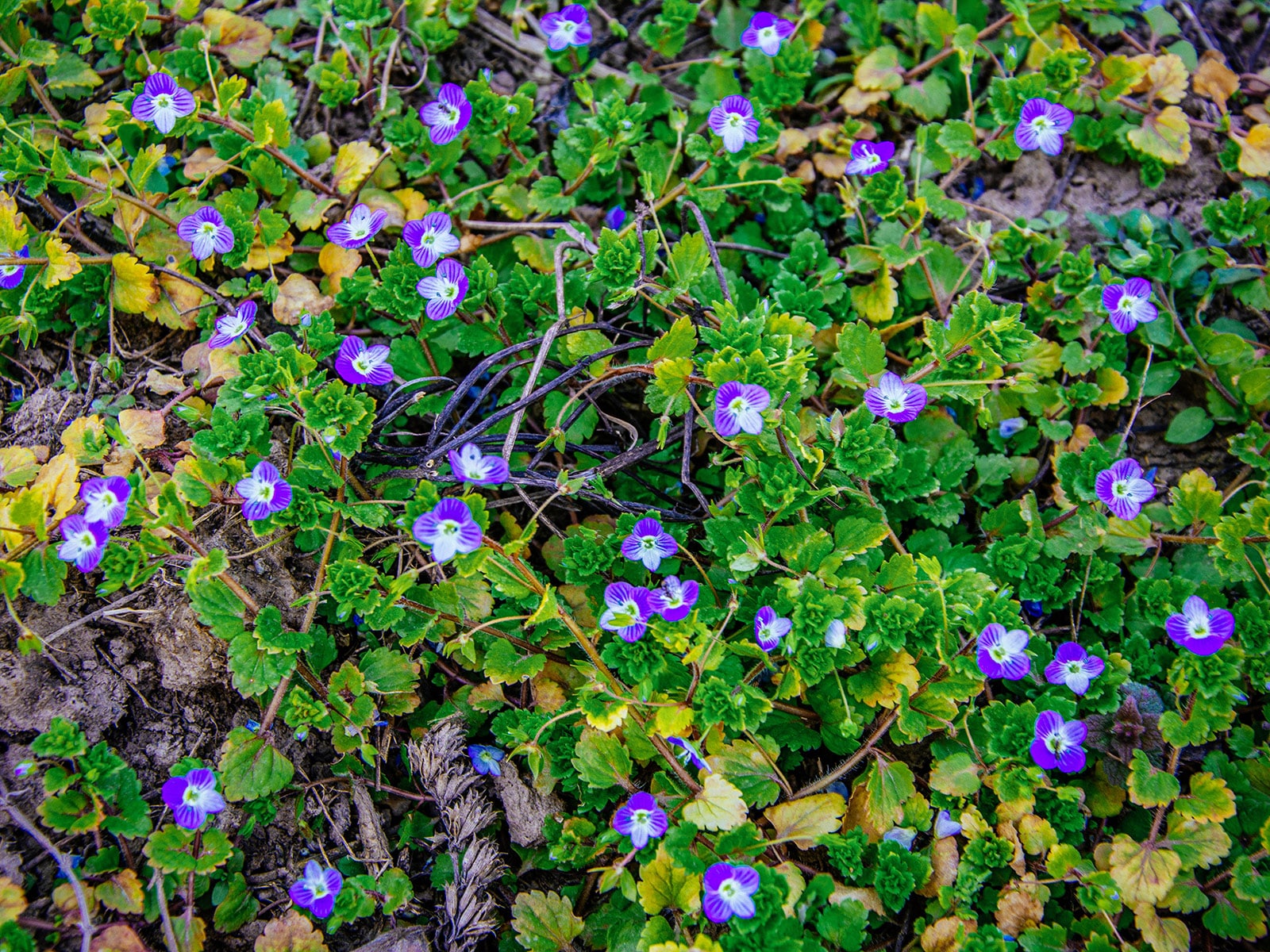
An excellent groundcover plant that stays very low (no more than 3 inches), creeping speedwell is a carpet-like plant with shiny leaves and tiny white to purple blooms. It’s known for being unfussy and somewhat tolerant of foot traffic, and it doesn’t need full sun to thrive.
This species makes a particularly great choice to grow between paving stones or in a rock garden. But, it’s versatile enough that you can do pretty much anything you want with it as long as you plant it in well-draining soil.
My pick
Veronica repens ‘Sunshine’ is an attractive cultivar with golden foliage.
- Soil type: Well-draining
- USDA Zones: 4 to 8
- Water: Medium
- Withstands foot traffic: Light
Hardy geranium (Geranium x cantabrigiense)
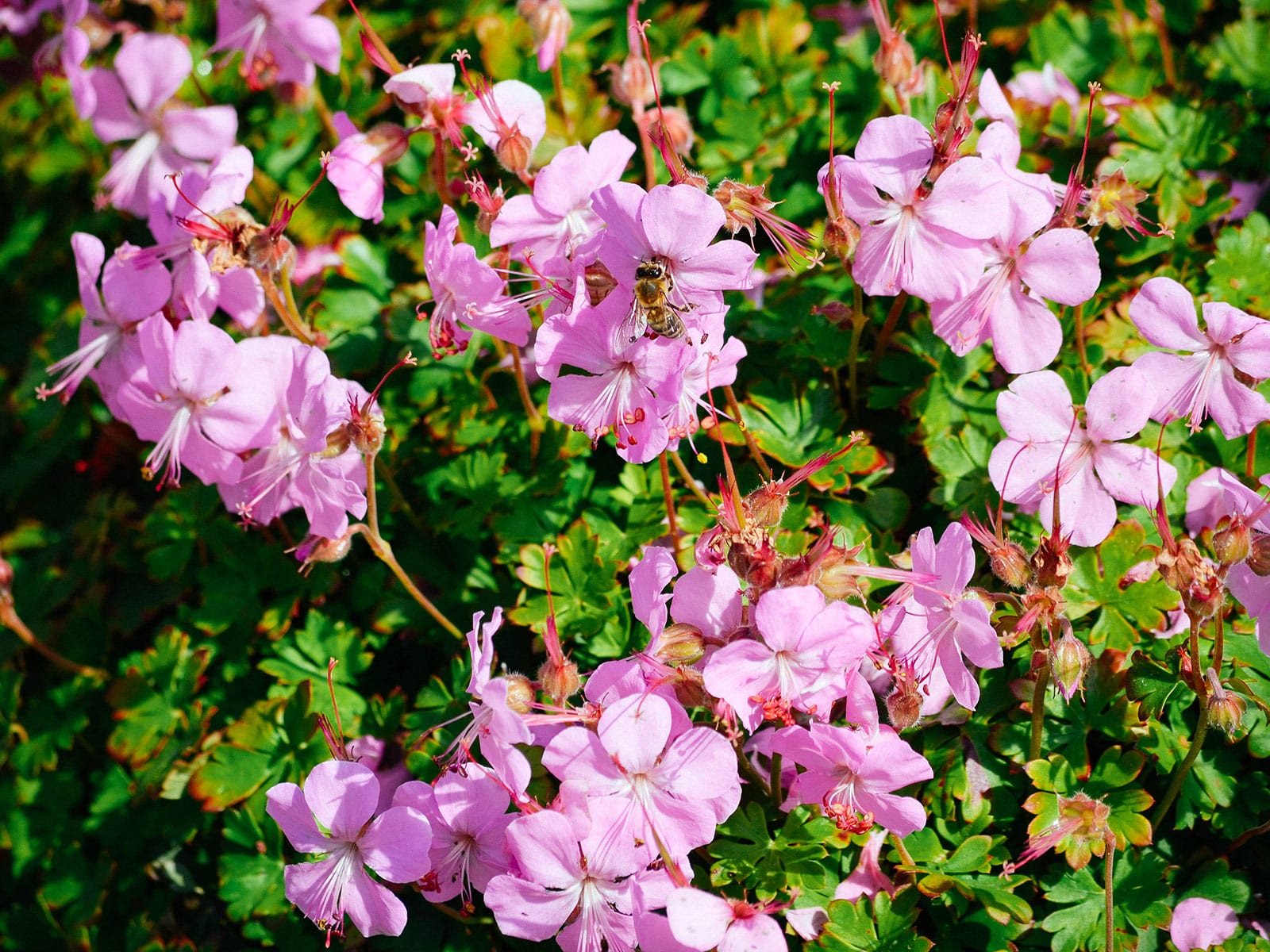
Also known as hardy geranium or cranesbill, Geranium x cantabrigiense is another excellent choice for partially shaded locations, especially if you’re a flower lover. Available in a range of different flower colors, from white to pink and purple, this hybrid plant grows to a maximum height of around 12 inches.
Hardy geranium likes lightly moist but well-draining soil and doesn’t need a lot of sun to thrive. It grows quickly, attracts butterflies, and will even tolerate being stepped on from time to time. In autumn, the leaves take on a bright red and orange color before partially dying back.
- Soil type: Well-draining and loamy
- USDA Zones: 4 to 8
- Water: Medium
- Withstands foot traffic: Light
Goldenstar (Chrysogonum virginianum)
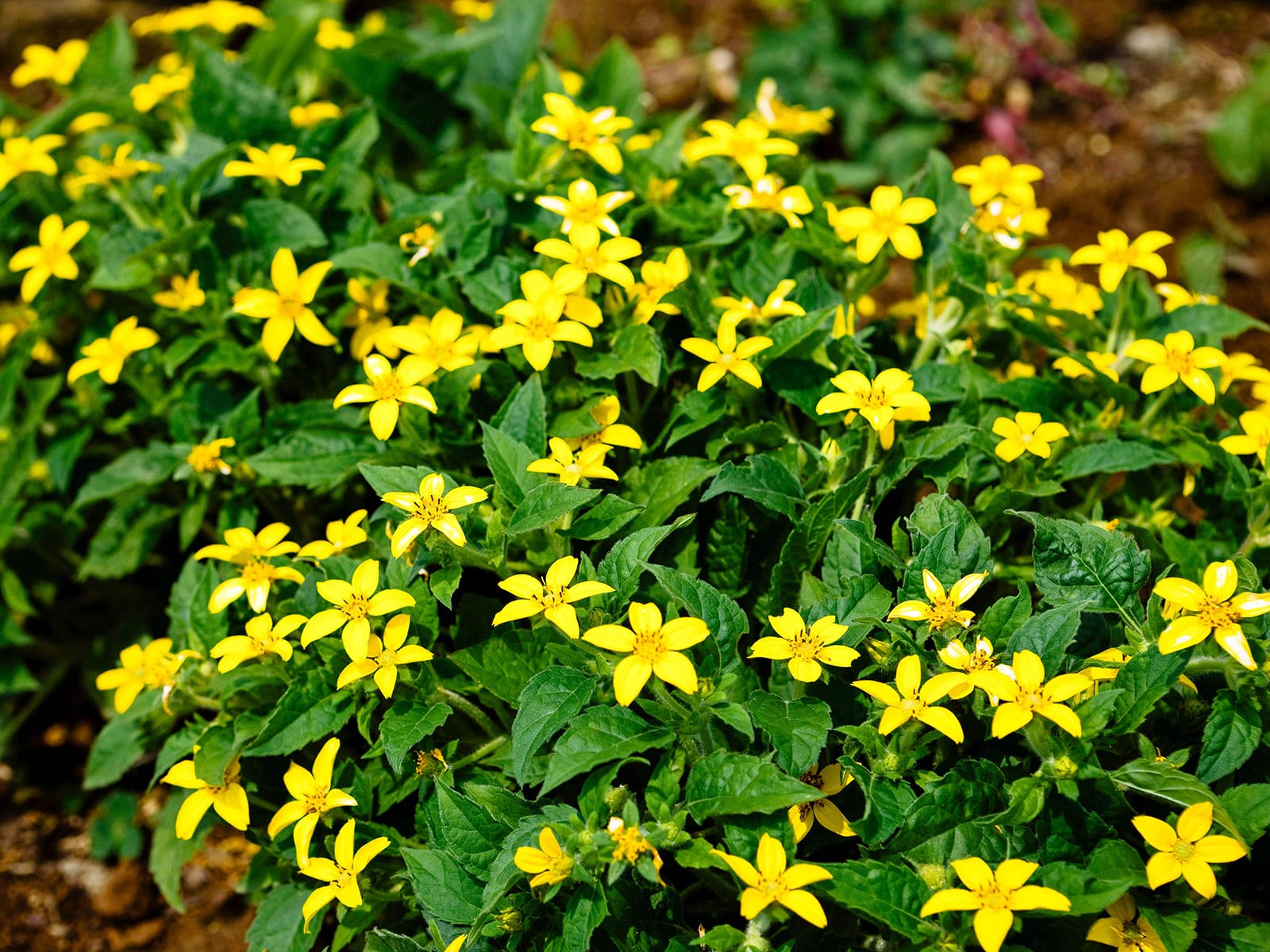
Here’s another one for the native garden. The goldenstar, scientifically known as Chrysogonum virginianum, is naturally found in woodlands in the eastern USA. It grows to a maximum height of around 12 inches and is commonly grown as a groundcover, mostly for its long-lasting, yellow flowers.
This hardy perennial will appreciate a relatively shaded spot that offers protection from the harsh summer sun. It prefers moist but well-draining soil, but is really not that picky about the conditions it grows in. Just don’t step on it too often; it doesn’t tolerate foot traffic very well.
- Soil type: Rich but well-draining
- USDA Zones: 5 to 9
- Water: Medium
- Withstands foot traffic: No
Corsican mint (Mentha requienii)
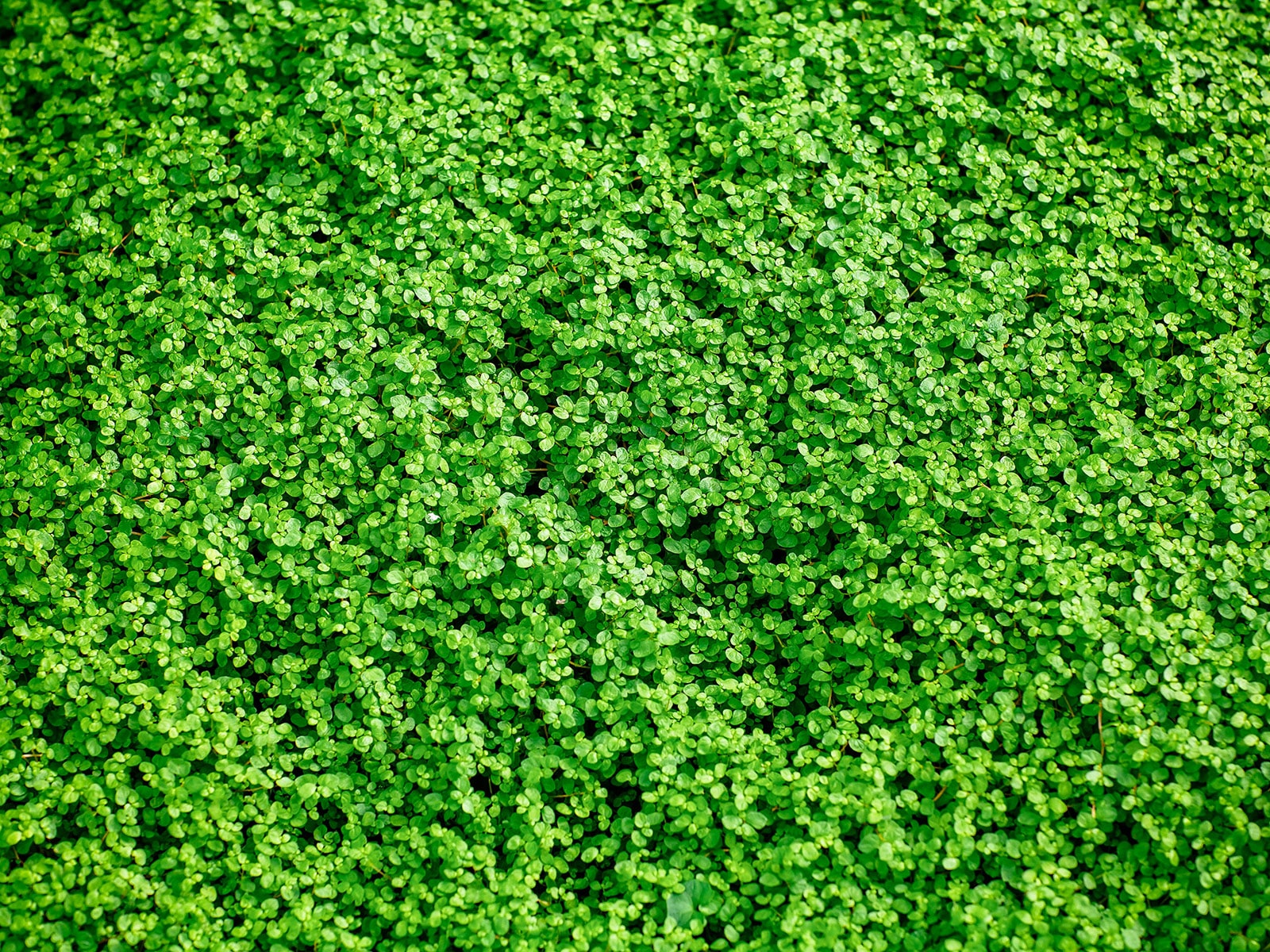
I bet you’ve never seen a mint plant this tiny! Better known as Corsican mint, Mentha requienii is one of the smallest members of the mint family, making it the perfect choice if you’re looking for a super-low groundcover. It rarely reaches 4 inches in height.
Native to the Mediterranean, Corsican mint is a vigorous grower that’s easy to care for and forms dense mats. It produces tiny light purple flowers, but the best thing about this plant is that, despite it size, it really is a true mint. It smells divine and has that typical sweet, minty flavor.
- Soil type: Moist but well-draining
- USDA Zones: 6 to 9
- Water: Medium
- Withstands foot traffic: Light
Spotted deadnettle (Lamium maculatum)
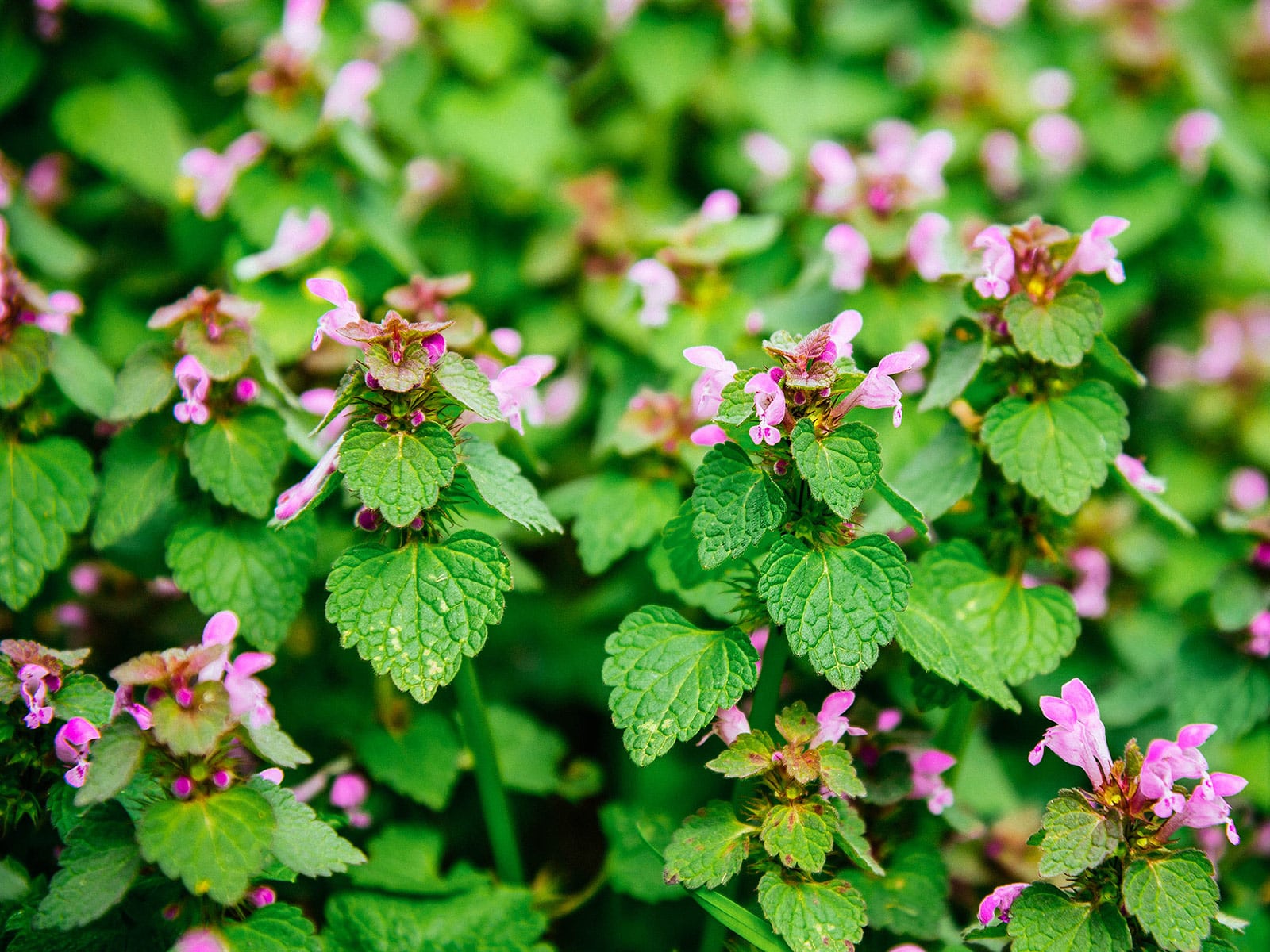
Another member of the mint family makes the list! Although it can look a little like a stinging nettle plant from a distance, Lamium maculatum is a deadnettle, so you can touch it without having to worry about a painful rash. It has pretty purple flowers and patterned foliage, plus (bumble)bees love it.
Spotted deadnettle plants can reach around 9 inches in height. They don’t need a lot of light to thrive and are quite vigorous, so they can quickly carpet large areas and smother annoying weeds. Keep an eye out for the various beautiful cultivars, like the silvery ‘Ghost’ and the pink-flowered ‘Shell Pink’.
- Soil type: Moist but well-draining
- USDA Zones: 3 to 8
- Water: Medium
- Withstands foot traffic: Light
Creeping jenny (Lysimachia nummularia)
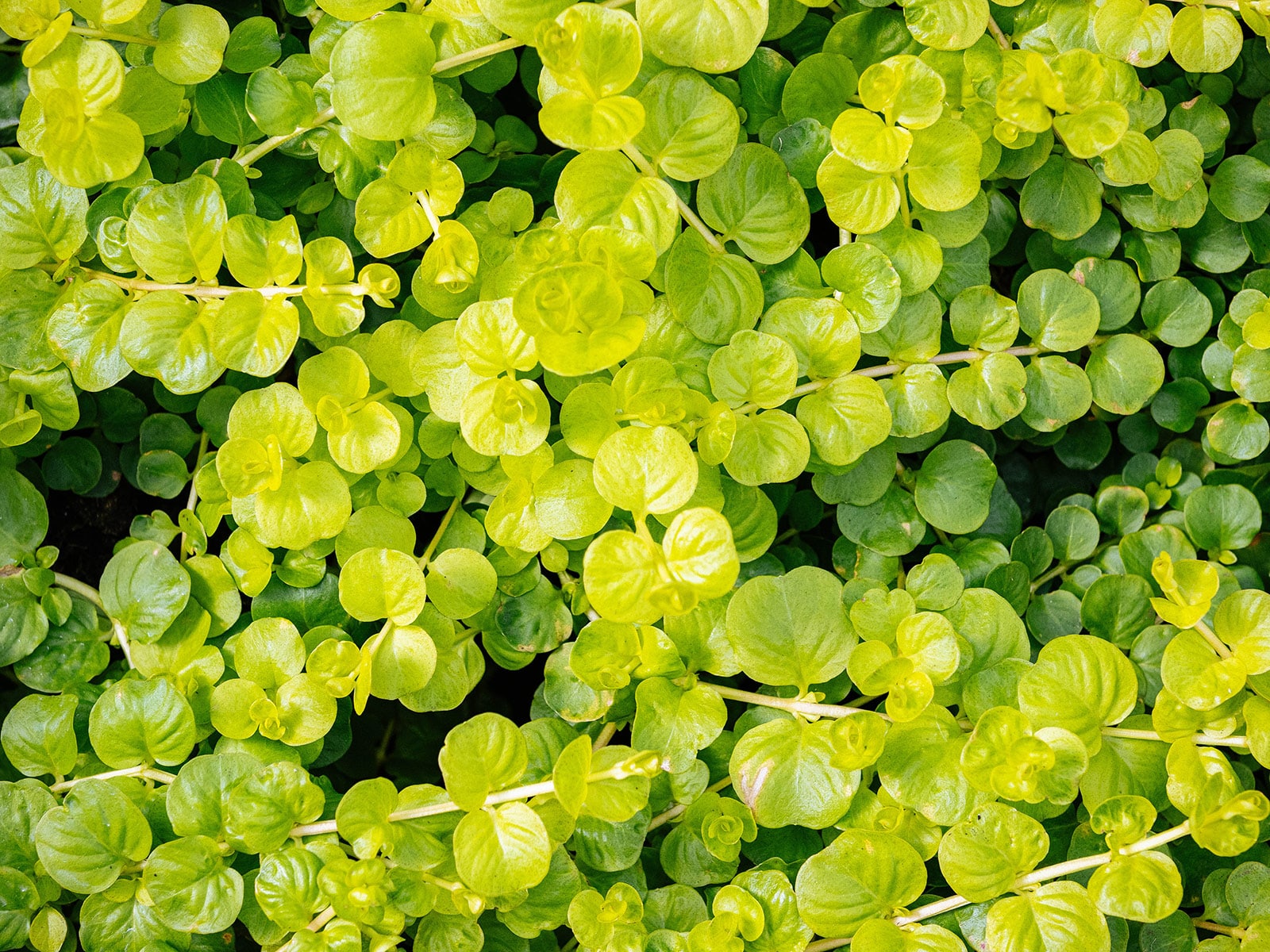
A classic groundcover plant, creeping jenny is a low-growing creeper that usually doesn’t surpass 4 inches in height. Though it can also grow in full sun, it does best in partial shade, especially in hot climates. This plant forms dense mats with the pretty texture of tiny, round leaves.
While the wild-type plant is green, most gardeners nowadays opt for a golden creeping jenny cultivar, which has lighter, yellowish-green foliage. The golden varieties go by a few different names, including ‘Aurea’, ‘Goldilocks’, and more.
Did you know?
Creeping jenny plants love water and will grow well around your pond. In fact, this is actually a popular aquarium plant (usually called moneywort in the aquarium hobby) that can adapt to growing fully submerged!
- Soil type: Moist but well-draining
- USDA Zones: 3 to 9
- Water: Medium to high
- Withstands foot traffic: Light
Disclosure: If you shop from my article or make a purchase through one of my links, I may receive commissions on some of the products I recommend.
Where to buy
Ground covers for shade
Full shade (less than 4 hours of sun)
Sweet woodruff (Galium odoratum)
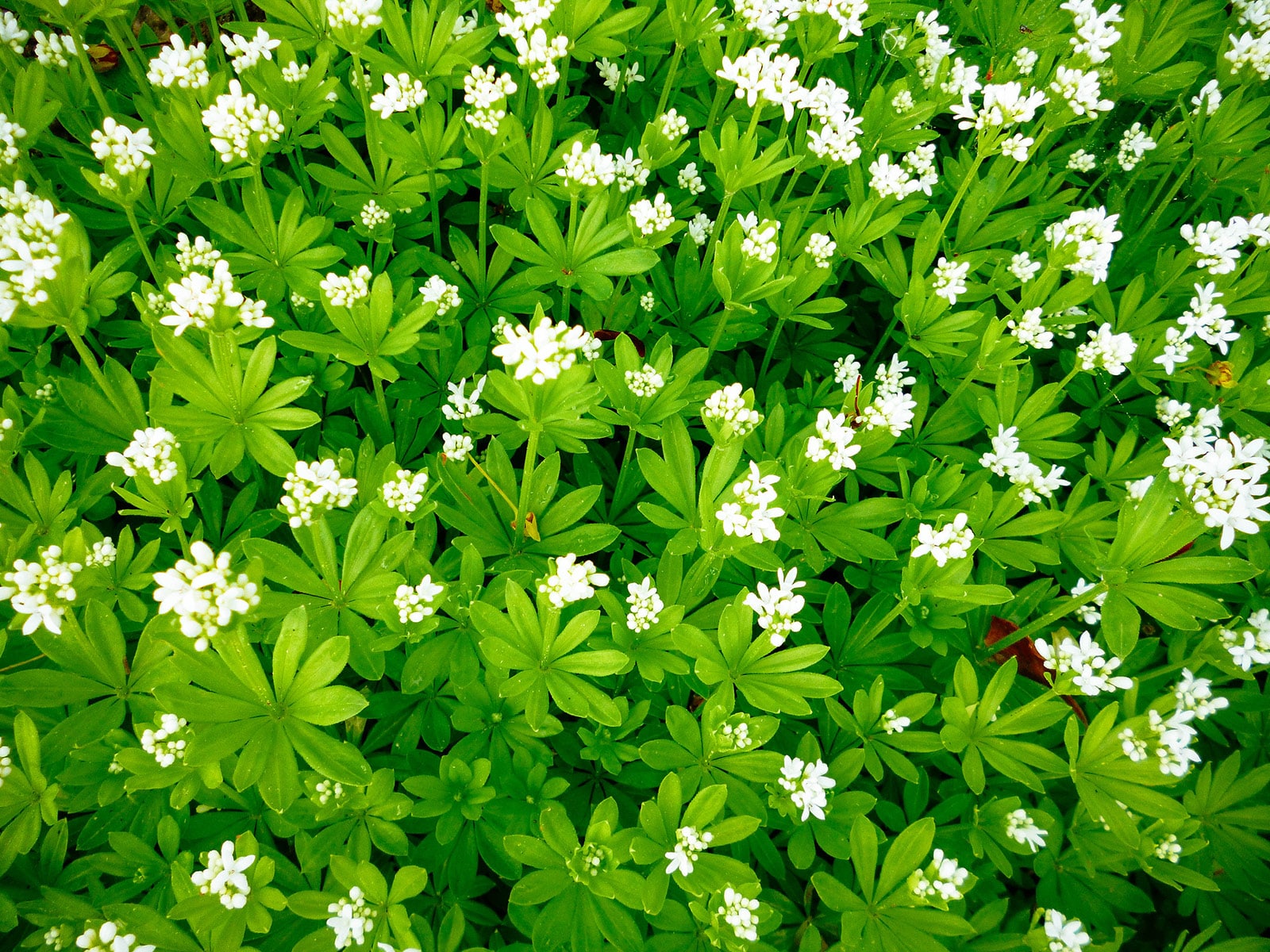
With its carpeting habit, star-shaped foliage, and tiny white flowers, sweet woodruff is one of my personal favorite ground cover plants on this list. And its virtues don’t end there—aside from its good looks, sweet woodruff also smells wonderful, similar to tonka beans. You can dry the leaves to use in potpourris.
Sweet woodruff, which grows to a maximum height of around 6 inches, makes a great choice for lower-light areas. It’s naturally found in woodland, where taller trees provide shade, so it doesn’t actually like being exposed to full sun. It’s easy to grow and quite vigorous.
- Soil type: Moist but well-draining
- USDA Zones: 4 to 8
- Water: Medium
- Withstands foot traffic: No
Strawberry begonia (Saxifraga stolonifera)
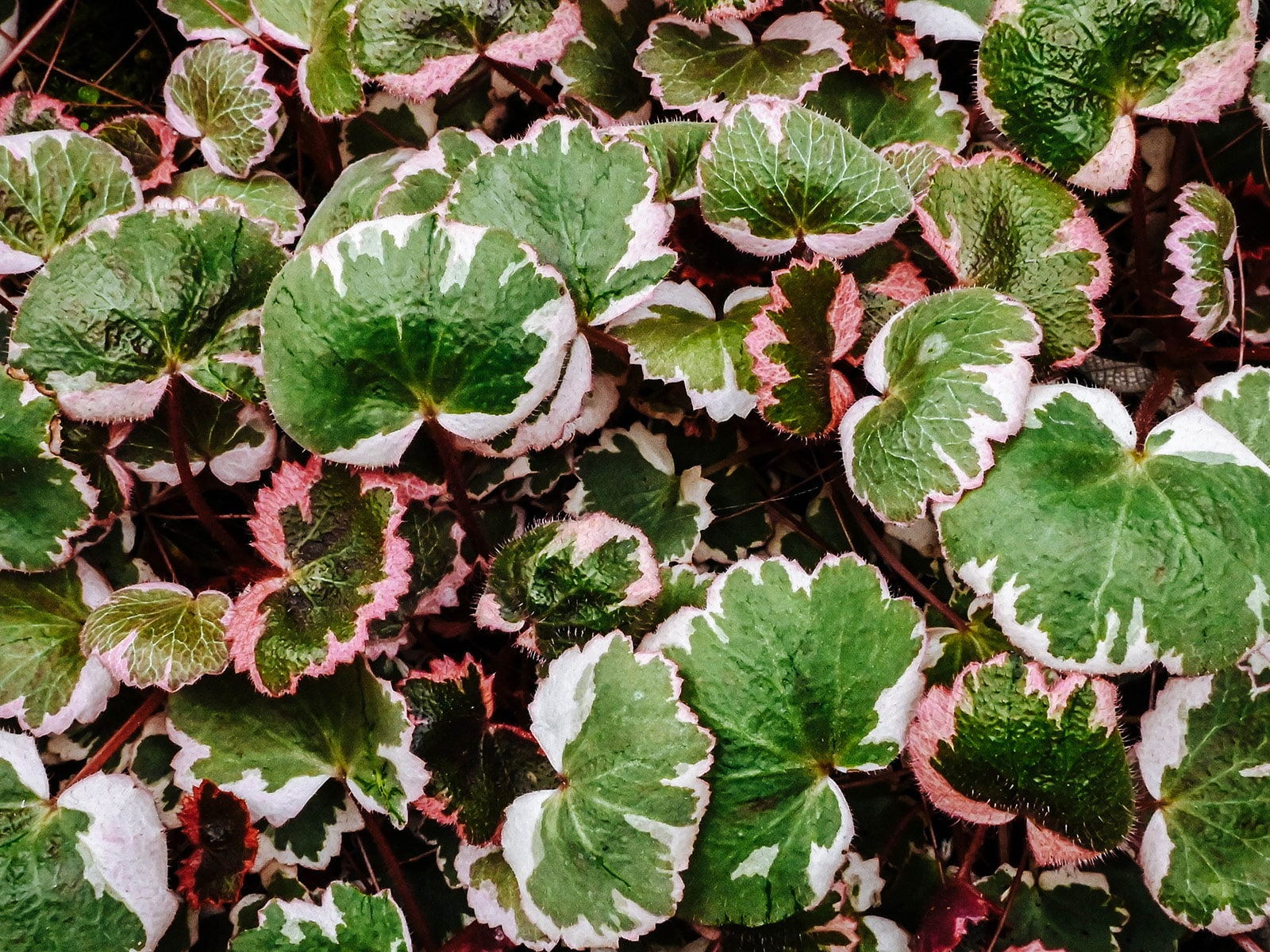
Despite its common name, the strawberry Begonia really isn’t a Begonia at all. I can see why people refer to it as such, though, because it has beautifully patterned foliage similar to that of true Begonias! The leaves are dark green with silvery veins.
Similar to strawberry plants, strawberry begonias spread through stolons, also sometimes known as runners. The species grows around 8 inches tall and doesn’t mind shaded conditions. During early summer, healthy plants will send up elegant white to pink flowers on long stalks.
Quick Tip
For those who like a pop of color, there’s a strawberry begonia cultivar with pink leaf edges called Saxifraga stolonifera ‘Tricolor’. It’s my personal favorite!
- Soil type: Rich but well-draining
- USDA Zones: 6 to 9
- Water: Medium
- Withstands foot traffic: No
Japanese spurge (Pachysandra terminalis)
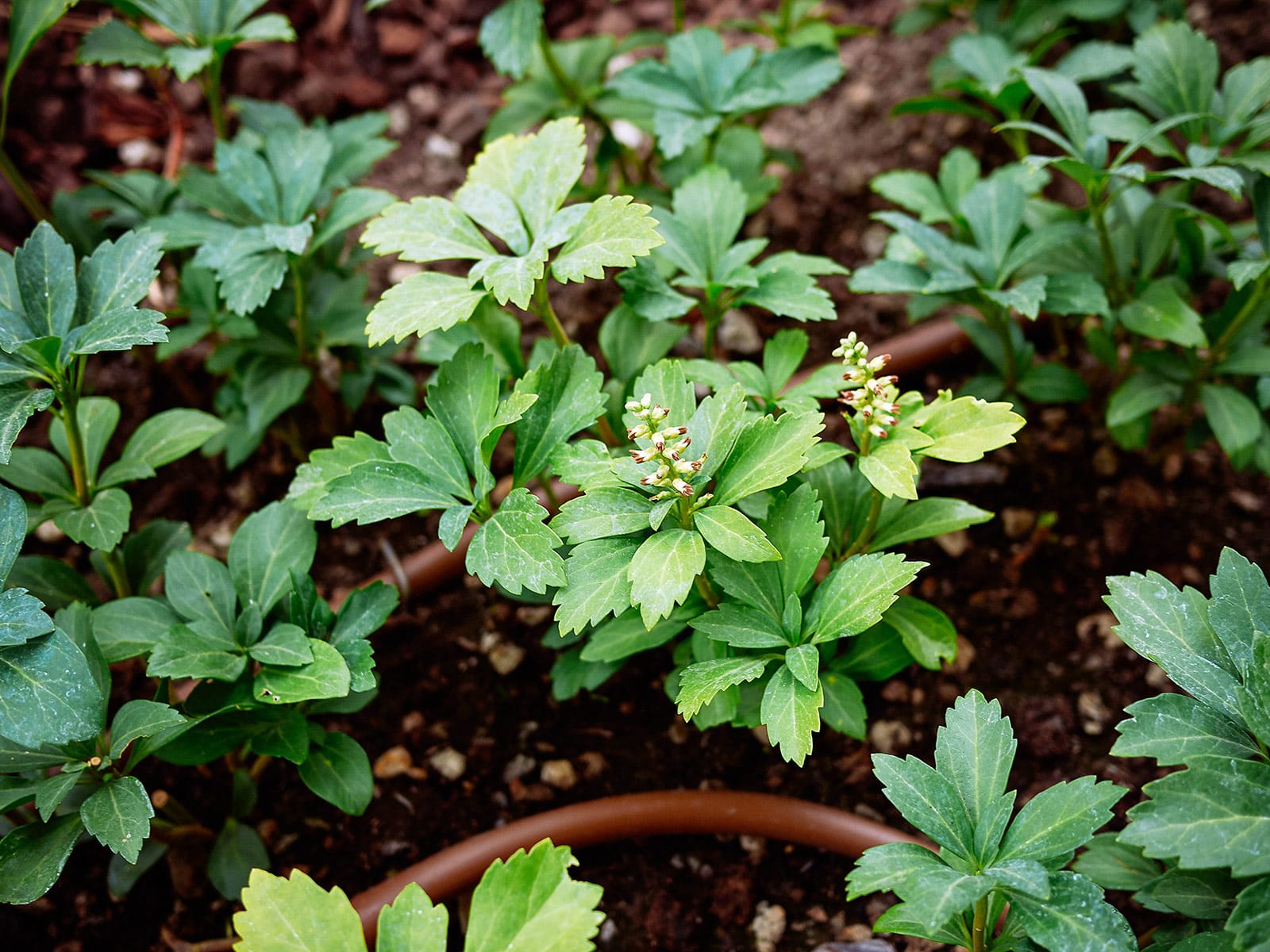
Another groundcover that prefers shade more than sun, Japanese spurge is perfect if you’re looking for a plant that stays very low: it rarely goes over 4 inches in height. Although this is a relatively slow grower, it can form dense mats over time, and its glossy foliage and tiny white flowers make it a highly decorative choice.
Japanese spurge is beloved by gardeners for its unfussy nature. It can grow in poor soil, is unattractive to rabbits and deer, and doesn’t mind the occasional drought. The cultivar ‘Silver Edge’ features lovely variegation on its star-shaped leaves.
- Soil type: Moist but well-draining
- USDA Zones: 5 to 9
- Water: Medium
- Withstands foot traffic: Light
Wild ginger (Asarum spp.)
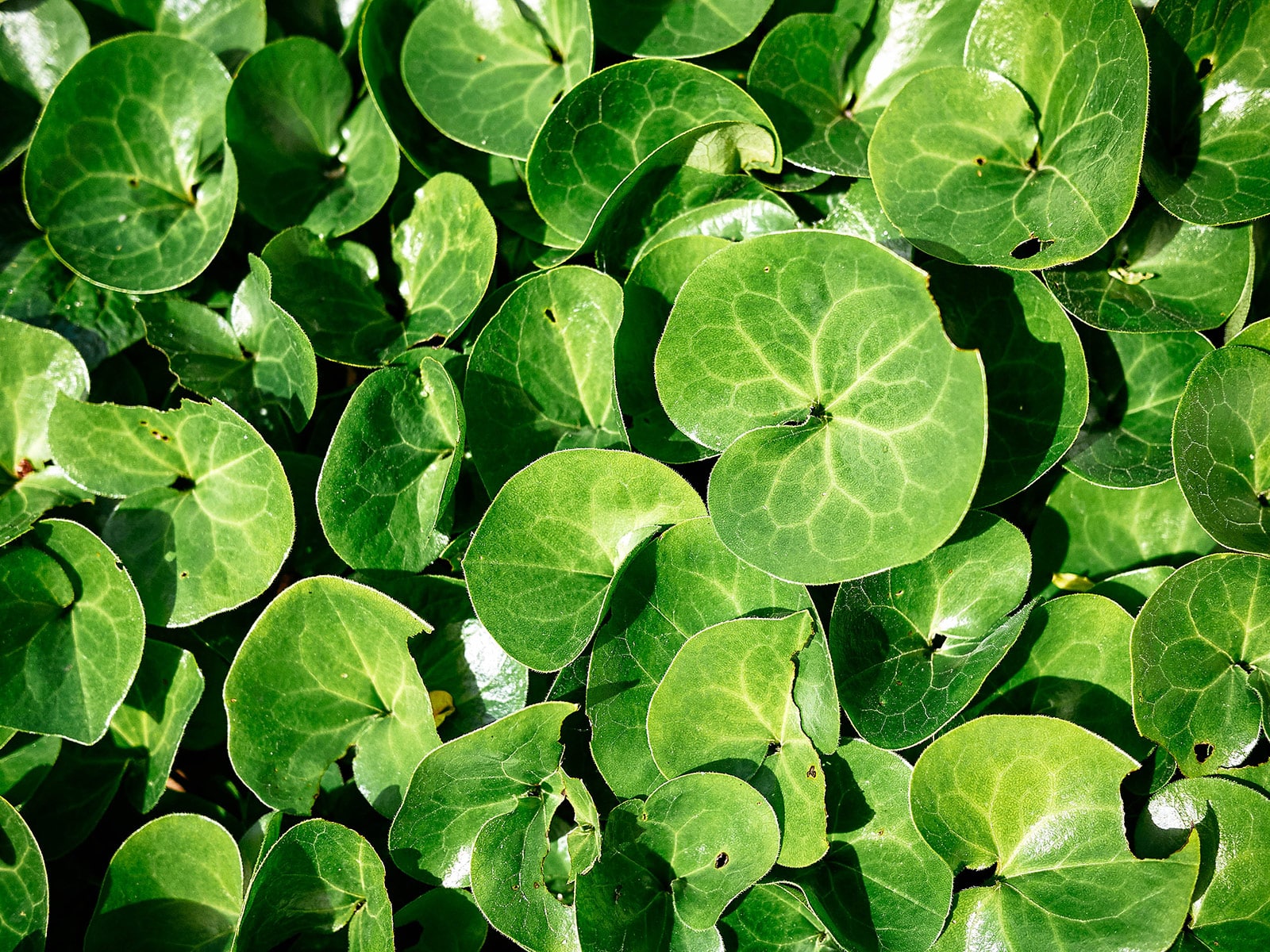
Another plant with a confusing common name, wild ginger isn’t a ginger at all—it doesn’t even belong to the same plant family. In fact, it’s toxic, so don’t try to use it to flavor your food! Do, however, use it as groundcover in your garden, because it’s easy to care for and can eventually form dense mats. I love the look of the nearly perfectly round leaves.
Place your wild ginger in a shaded spot where the soil stays relatively moist. Keep an eye out for the unusual small reddish flowers, which hang down below the leaves. These are meant to attract small flies as soon as they emerge from the ground in spring. After the plant finishes blooming, its seeds are spread by ants.
- Soil type: Moist but well-draining
- USDA Zones: 4 to 8
- Water: Medium
- Withstands foot traffic: No
Dwarf periwinkle (Vinca minor)
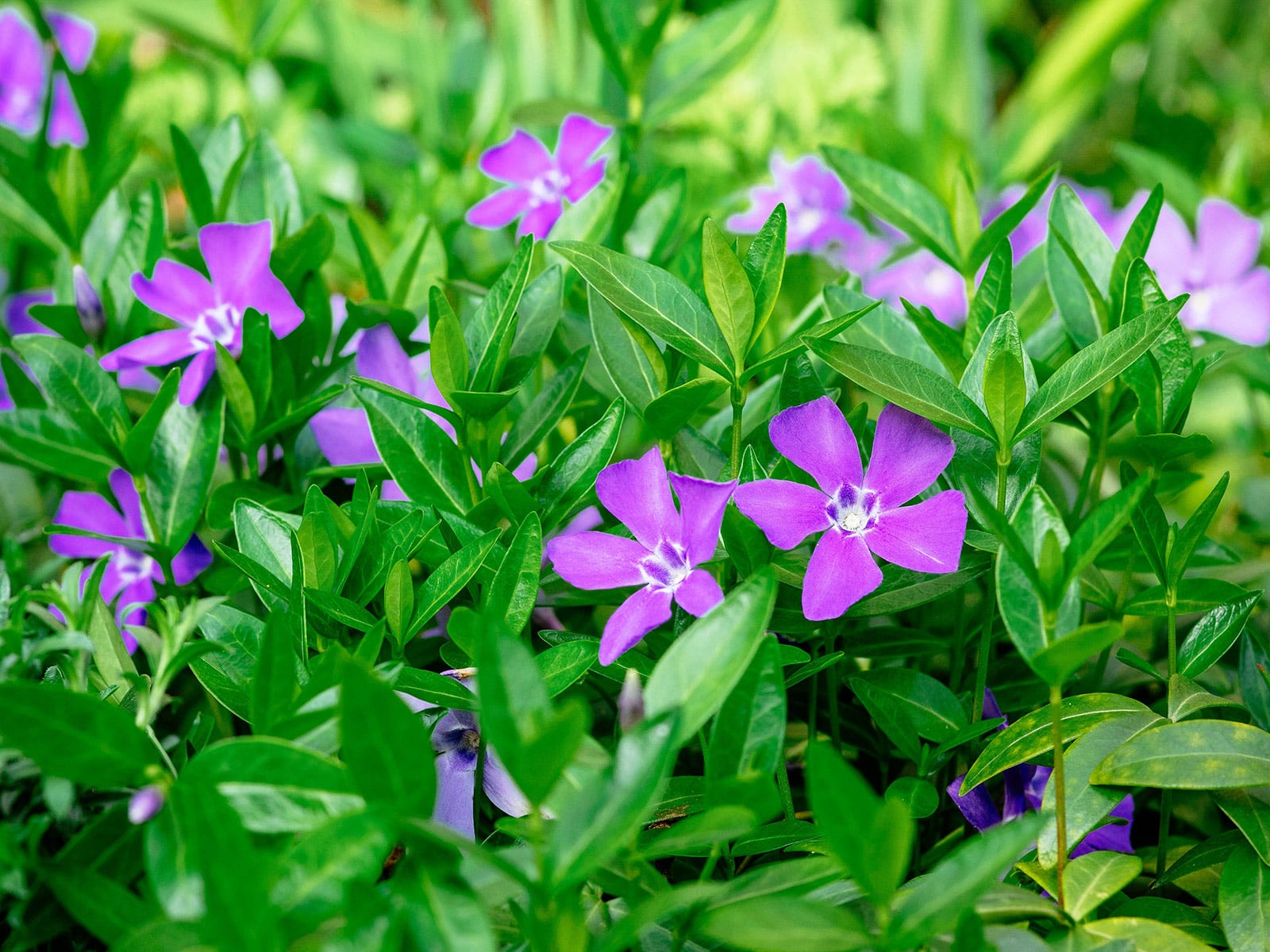
Nothing screams “woodland in spring” quite like a lush carpet of blueish-purple dwarf periwinkle flowers! This low-growing sprawling plant makes an excellent ground cover, and even when it’s not blooming (which it does from spring to fall in most climates), its glossy leaves really help spruce up the shady spots in your garden.
There are plenty of fun dwarf periwinkle cultivars available. Some have different flower colors, like white (called ‘Alba’) or dark purple (called ‘Atropurpurea’). Others have variegated leaves, like golden (‘Illumination’) or cream (‘Argenteovariegata’). Just be sure to keep your plant contained, because this species is a very vigorous grower.
- Soil type: Well-draining
- USDA Zones: 4 to 8
- Water: Medium
- Withstands foot traffic: Moderate
Redwood sorrel (Oxalis oregana)

One of the loveliest native ground cover plants around, redwood sorrel is naturally found in the moist woodlands of the western USA. This one’s perfect for shade gardens, as it really doesn’t need (or like) too much sun: its leaves have actually adapted to fold down when things get too hot or bright.
Sorrel sports short stems with three heart-shaped leaflets each. It’s reminiscent of clover, but the two are not related. Sorrel produces delicate, light pink, star-shaped blooms, quite different from clover’s globe-shaped flower clusters. You can even eat it; the leaves have a distinctly tangy taste due to their oxalic acid content.
- Soil type: Moist but well-draining
- USDA Zones: 7 to 9
- Water: Medium
- Withstands foot traffic: No
Dwarf lady’s mantle (Alchemilla erythropoda)
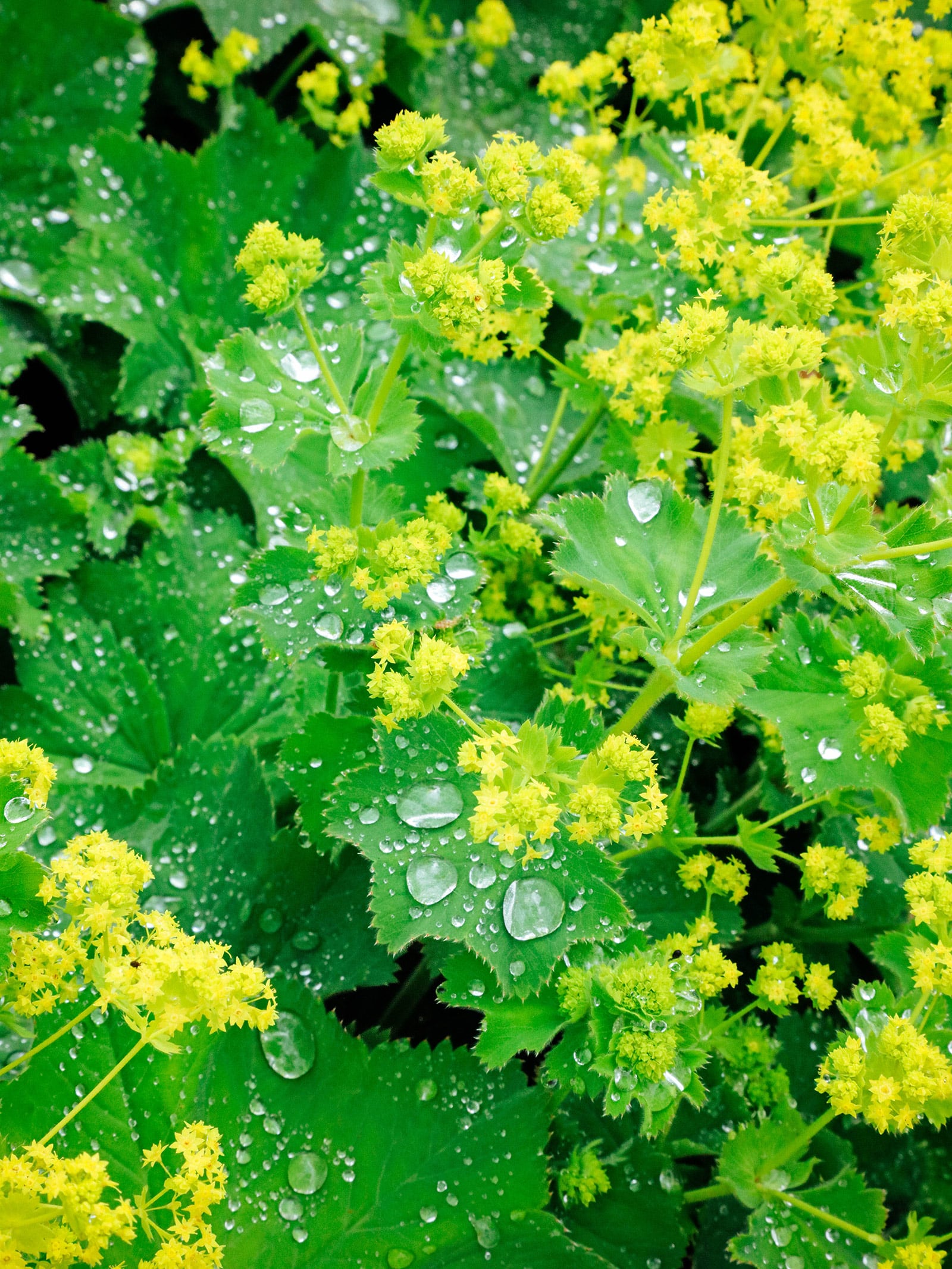
Plants of the genus Alchemilla, also known as lady’s mantle, are commonly grown as ground covers or along garden paths. They’re unique for their scalloped leaves, chartreuse sprays of tiny flowers, and the fact that their foliage exhibits the lotus effect (much like nasturtiums, another hydrophobic plant). Tiny hairs make the leaves “waterproof,” causing beads of dew to collect on them and sparkle beautifully in the sun.
Dwarf lady’s mantle grows 5 to 6 inches tall and 2 feet wide and is prone to self-seeding, so you can establish a large patch fairly quickly by letting it go (or collecting seeds to propagate in other areas of the yard).
Quick tip
There’s an even lower-growing species of lady’s mantle called Alchemilla ellenbeckii (carpet lady’s mantle). This one grows to a maximum of 4 inches tall and while it can be a little trickier to find than other species, it’s worth seeking out for its striking red stems.
- Soil type: Moist but well-draining
- USDA Zones: 4 to 7
- Water: Medium
- Withstands foot traffic: Light
Barrenwort (Epimedium spp.)
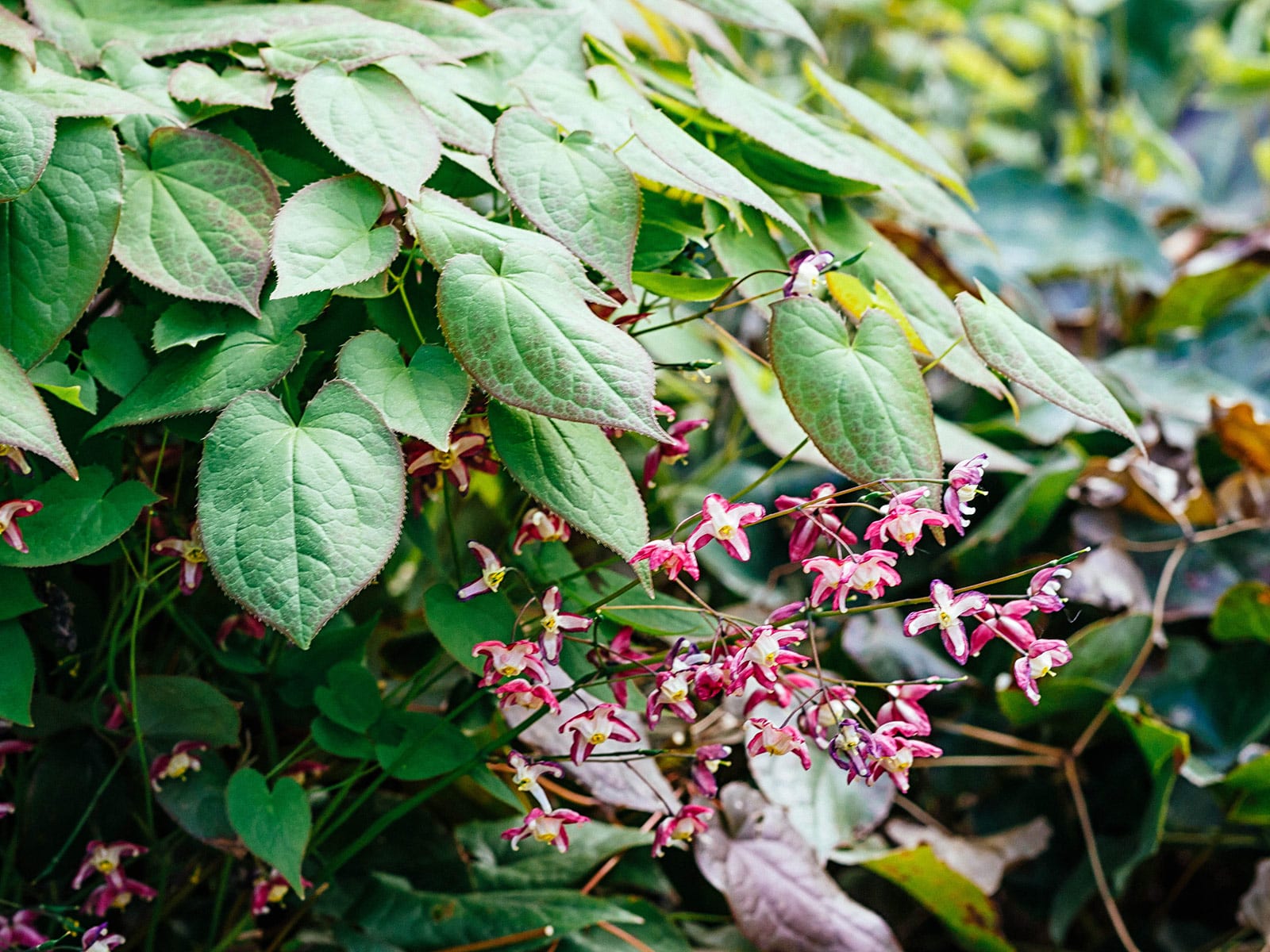
One of the prettiest plants on this list, in my opinion—and there are so many varieties to choose from! Barrenwort is mostly naturally found in China, but it’s a popular ground cover plant around the world thanks to its often colorful and patterned leaves, as well as its delicate, four-pointed blooms in different shades.
Barrenwort grows to around 12 inches in height. It thrives in low-light conditions and prefers plenty of organic material in its soil (think “forest floor”). Plants in this genus are known to be very hardy when established, and while they’re not the quickest growers, they can eventually form dense carpets.
My pick
There are too many barrenwort cultivars to even begin to try to discuss them all, but I especially like ‘Pretty in Pink’, ‘Songbirds’, and ‘Sandy Claws’.
- Soil type: Rich and well-draining
- USDA Zones: 5 to 8
- Water: Medium
- Withstands foot traffic: Light
Brass buttons (Leptinella squalida)
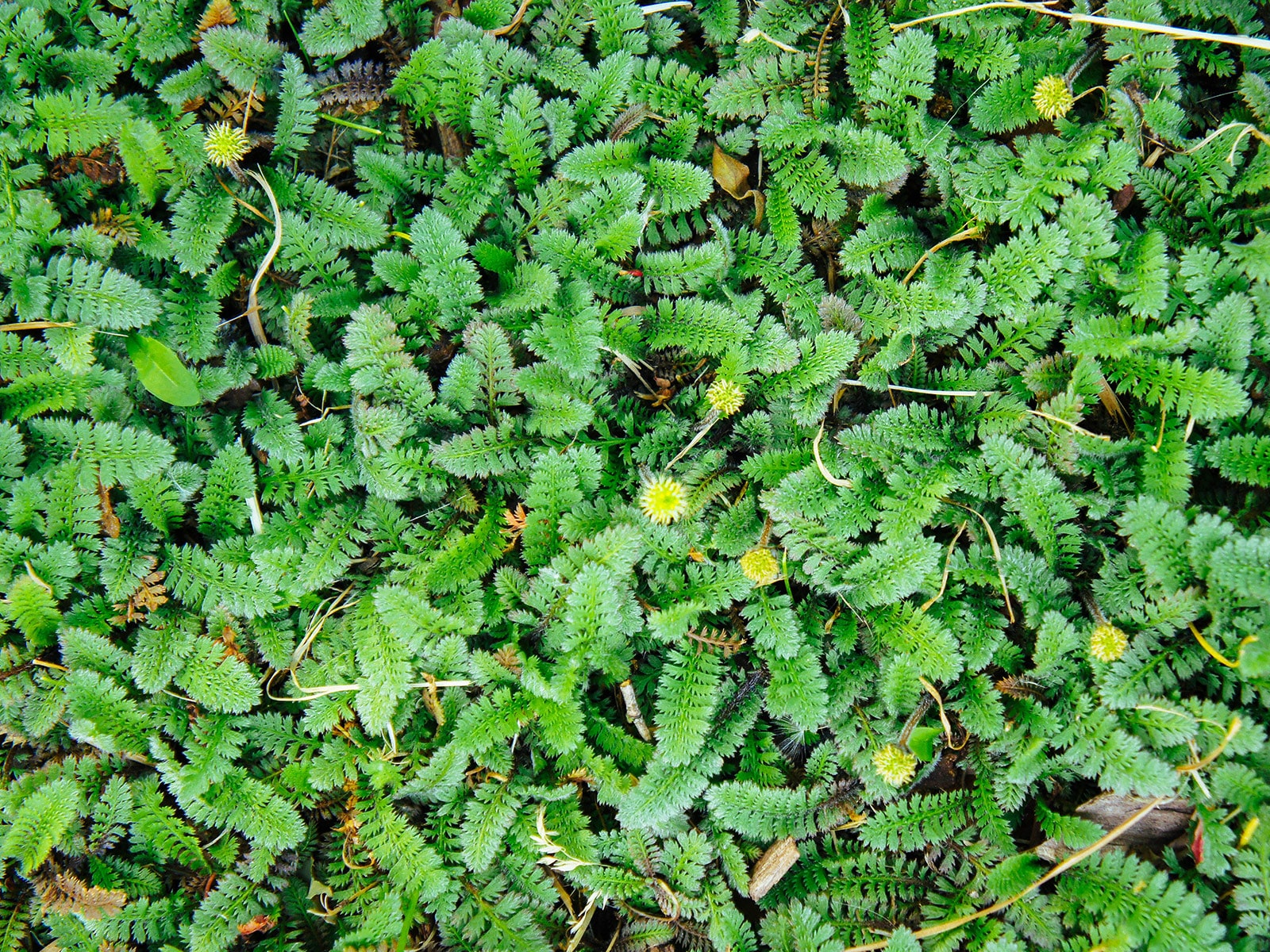
Is that a moss? Or maybe a mini fern? Nope, it’s the brass buttons plant! Though this species’ feathery foliage resembles tiny fern fronds, it actually belongs to the daisy family Asteraceae.
The brass buttons plant produces small, round flowers in shades of pale yellow, which explains the name. This one’s perfect if you want a very low-growing ground-cover, as it reaches little more than 2 inches in height. I can totally imagine it as a funky grass lawn replacement plant, as it does handle foot traffic pretty well. The most commonly grown variety of brass buttons plant is a dark-leaved cultivar called ‘Platt’s Black’.
- Soil type: Well-draining
- USDA Zones: 4 to 10
- Water: Medium
- Withstands foot traffic: Moderate
Bunchberry (Cornus canadensis)
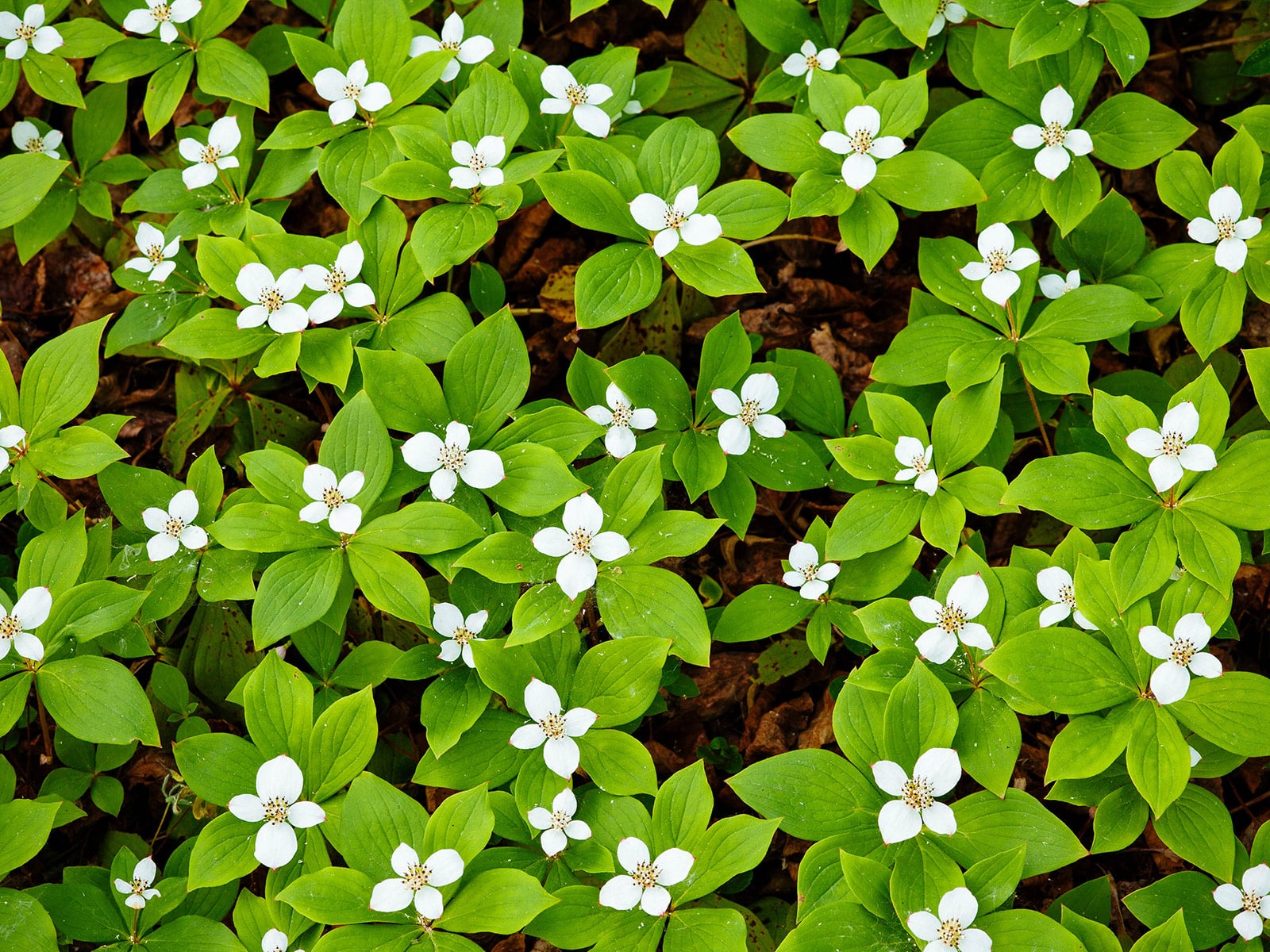
Another North American native makes the list! Cornus canadensis goes by many different names, but it’s most commonly referred to as bunchberry. This is a reference to the small bunches of bright red berries the species develops during late summer or early fall, after its delicate white flowers finish blooming.
At a maximum height of around 8 inches and thanks to its creeping growth pattern, bunchberry works well as a groundcover. It’s very cold-hardy, and since it’s naturally a woodland species, it doesn’t need a lot of light to thrive. Just make sure your bunchberry plants stay well-hydrated, as they like relatively moist soil.
- Soil type: Moist and acidic
- USDA Zones: 2 to 7
- Water: Medium to high
- Withstands foot traffic: No
Baby’s tears (Soleirolia soleirolii)

If you live in a warm climate and are looking for a very low-growing ground cover, the teeny tiny plant known as baby’s tears (or mind-your-own-business, or angel’s tears) may just be the right choice. This fast-growing species forms thick, lush carpets—in ideal conditions, it’ll look like someone threw a big green rug over your garden.
This perennial rarely grows more than 5 inches tall and is particularly suitable for moist locations like pond edges. Baby’s tears can withstand some foot traffic, and because it naturally grows in forested regions in its natural Mediterranean habitat, it doesn’t require a lot of light. In fact, it prefers shady locations, and will struggle in spots that receive a lot of direct sun.
- Soil type: Moist but well-draining
- USDA Zones: 9 to 11
- Water: Medium to high
- Withstands foot traffic: Light
Dwarf Solomon’s seal (Polygonatum humile)
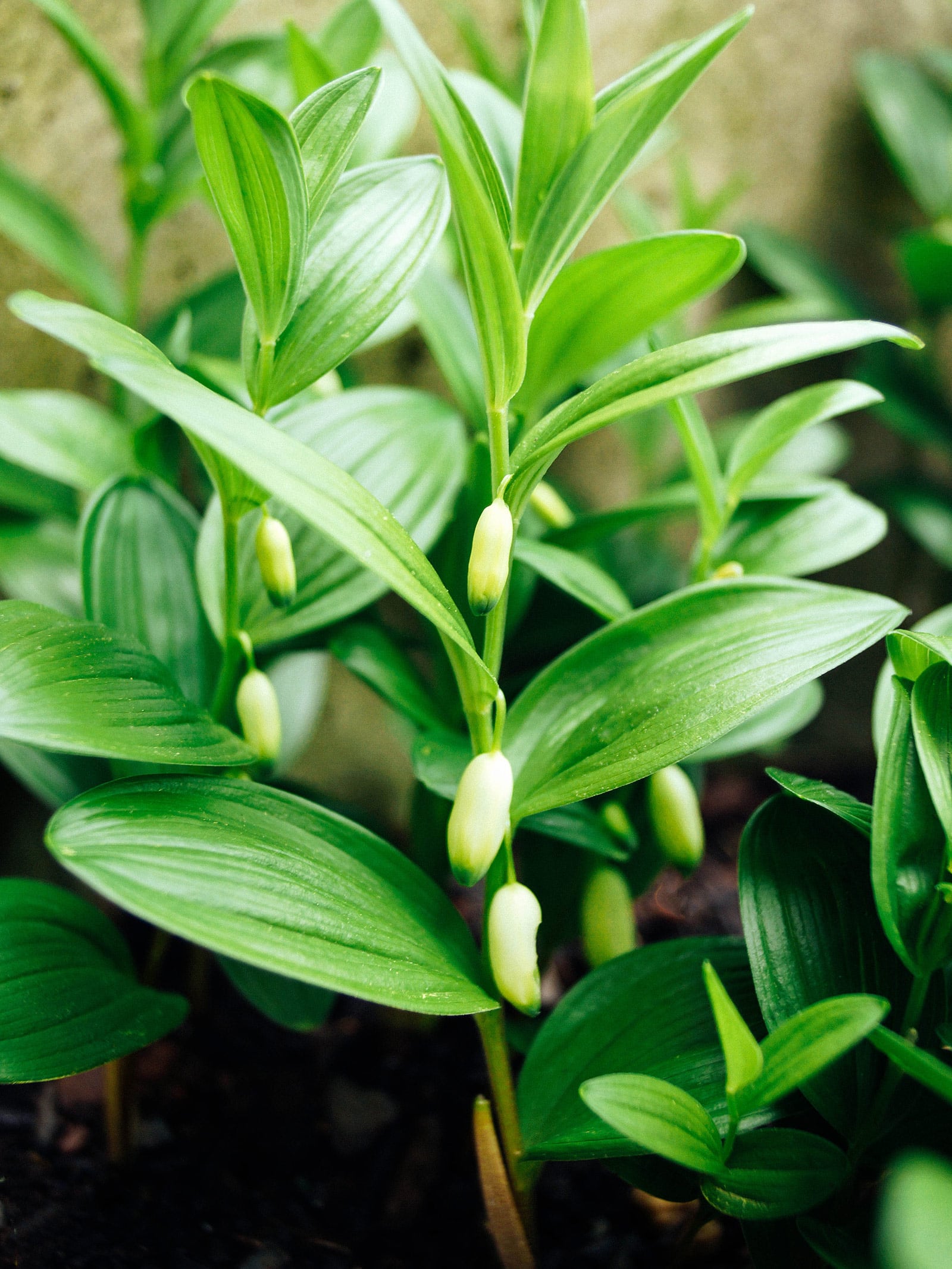
The Solomon’s seals of the genus Polygonatum make a great choice for the shade garden and are beautiful to look at, with arching stems and small, bell-like flowers. Most of these elegant plants are much too large to work as ground covers, but did you know there’s an exception? The dwarf Solomon’s seal, P. humile, only reaches around 10 inches in height.
Care for dwarf Solomon’s seal is similar to that of its full-sized cousins. It likes relatively moist soil and doesn’t like to be blasted with harsh sun, making it a great choice to plant as a ground cover between taller plants.
Quick tip
Keep in mind that even though they’re commonly cooked and eaten in their native country, China, these plants are toxic in their raw state. Keep your pets away from them—especially the berries.
- Soil type: Moist but well-draining
- USDA Zones: 3 to 8
- Water: Medium
- Withstands foot traffic: No
Wintercreeper (Euonymus fortunei)
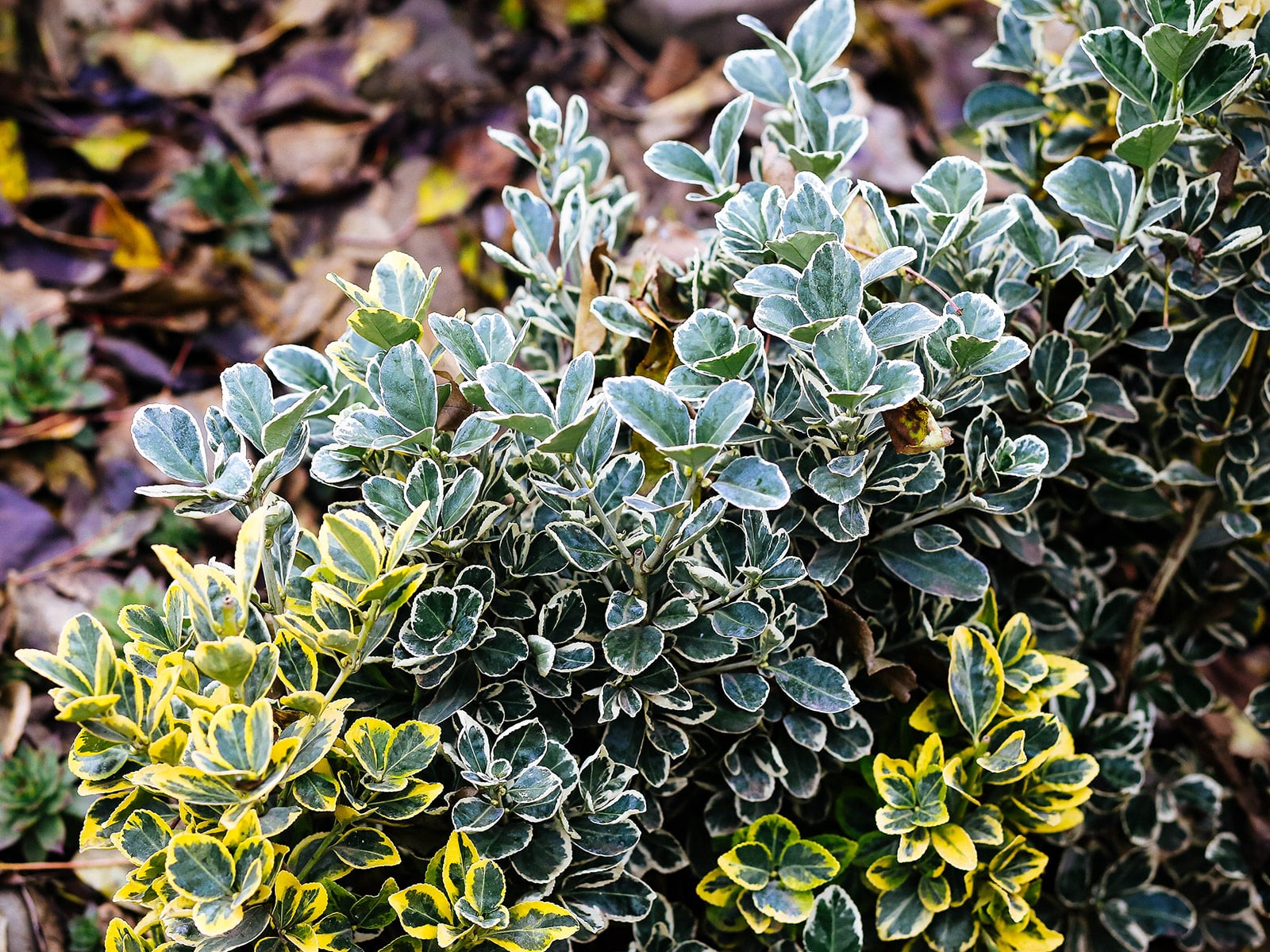
Also known (among various other common names) as fortune’s spindle, wintercreeper is a trailing plant that can be grown as a ground cover or trained up vertical surfaces like walls. Originally from East Asia, this species is a quick grower that does well in shaded areas and doesn’t need a lot of moisture to thrive.
Wintercreeper is popular for its versatility, and this has resulted in the production of a range of different cultivars. The wild form has all green foliage, but there are also variegated and even purple-leaved varieties!
- Soil type: Well-draining
- USDA Zones: 5 to 9
- Water: Medium
- Withstands foot traffic: Light


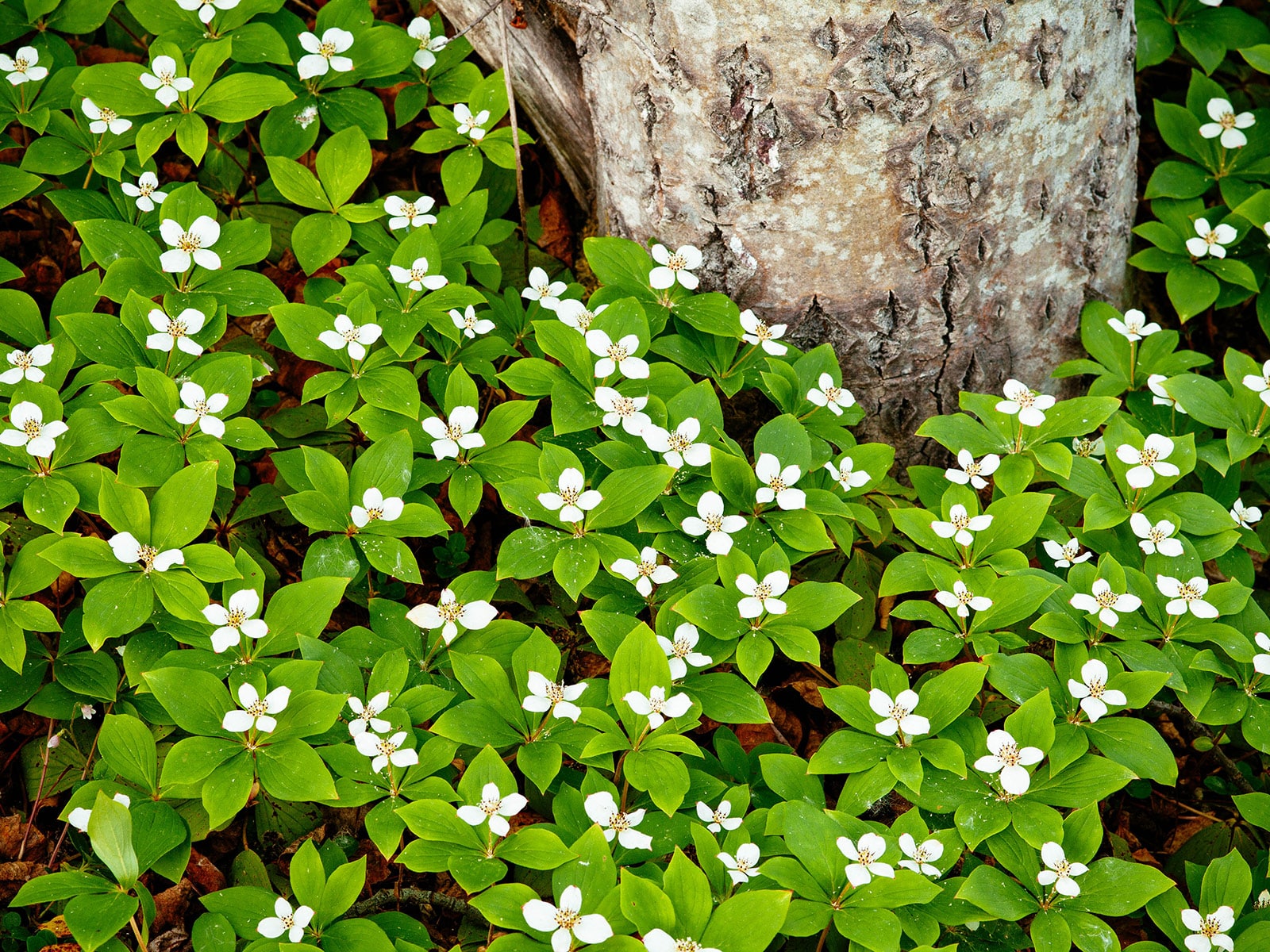













Great site. Lots of info. of those listed are any deer resistant? I love winter creeper, was growing in my front (N.Texas) lawn and deer had a banquet.
What a great list of shade loving ground plants, but, could any of these be considered invasive in that they can spread to lawn areas?
It depends on your climate. What’s considered invasive in one area may not be in another. And also, if you think about, the best ground covers should be fast-spreading to do their job well. You can check with your local Extension service to see if any of these are not recommended for your area.